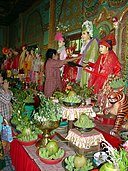Shwe Hpyin Nyidaw


Shwe Hpyin Nyidaw (Burmese: ရွှေဖျင်းညီတော်, pronounced [ʃwèbjɪ́ɰ̃ ɲìdɔ̀]; lit. 'Goldpot the Younger'), also called Shwe Hpyin Nge (ရွှေဖျင်းငယ်, IPA: [ʃwèbjɪ́ɰ̃ ŋɛ̀]) or Min Lay (မင်းလေး, IPA: [mɪ́ɰ̃ lé]), is one of the 37 nats in the official pantheon of Burmese nats. Together known as Shwe Hpyin Nyinaung (Brothers) or Taungbyon Min Nyinaung (Brother Lords), he and his brother Shwe Hpyin Naungdaw were sons of Byatta, the royal messenger, and Me Wunna, a flower-eating ogress from Mount Popa, during the reign of King Anawrahta of Bagan. They were killed for neglecting their duty to provide a brick each thus leaving gaps in Taungbyone Pagoda, which was built by King Anawrahta.[1][2] They are portrayed on pedestals, one lying down and the other upright with his sword shouldered arrogantly.[3] Me Wunna died of a broken heart after Byatta was killed and later their sons were taken away on the king's orders. She became a nat known as Popa Medaw (Mother of Popa).[4]
Worshippers of this nat avoid consumption of pork, as Shwe Hpyin Gyi's father, Byatta, is believed to have been an Indian Muslim.[5]
References[]
- ^ Shwe Mann Maung. "The Taung Byone Nat Festival". Perspective (August 1997). Archived from the original on 2004-07-17. Retrieved 2008-09-11.
- ^ DeCaroli, Robert (2004). Haunting the Buddha: Indian Popular Religions and the Formation of Buddhism. Oxford University Press, US. ISBN 978-0-19-516838-9. Retrieved 2008-09-13.
- ^ Hla Thamein. "Thirty-Seven Nats". Yangonow. Archived from the original on 2006-06-24. Retrieved 2006-07-03.
- ^ Spiro, Melford E (1996). Burmese Spiritualism. Transaction Publishers. ISBN 978-1-56000-882-8. Retrieved 2008-09-15.
- ^ Gilbert, David (15 August 2013). "Myanmar's Multicultural Spirits". The Irrawaddy. Retrieved 8 September 2013.
- Burmese nats
